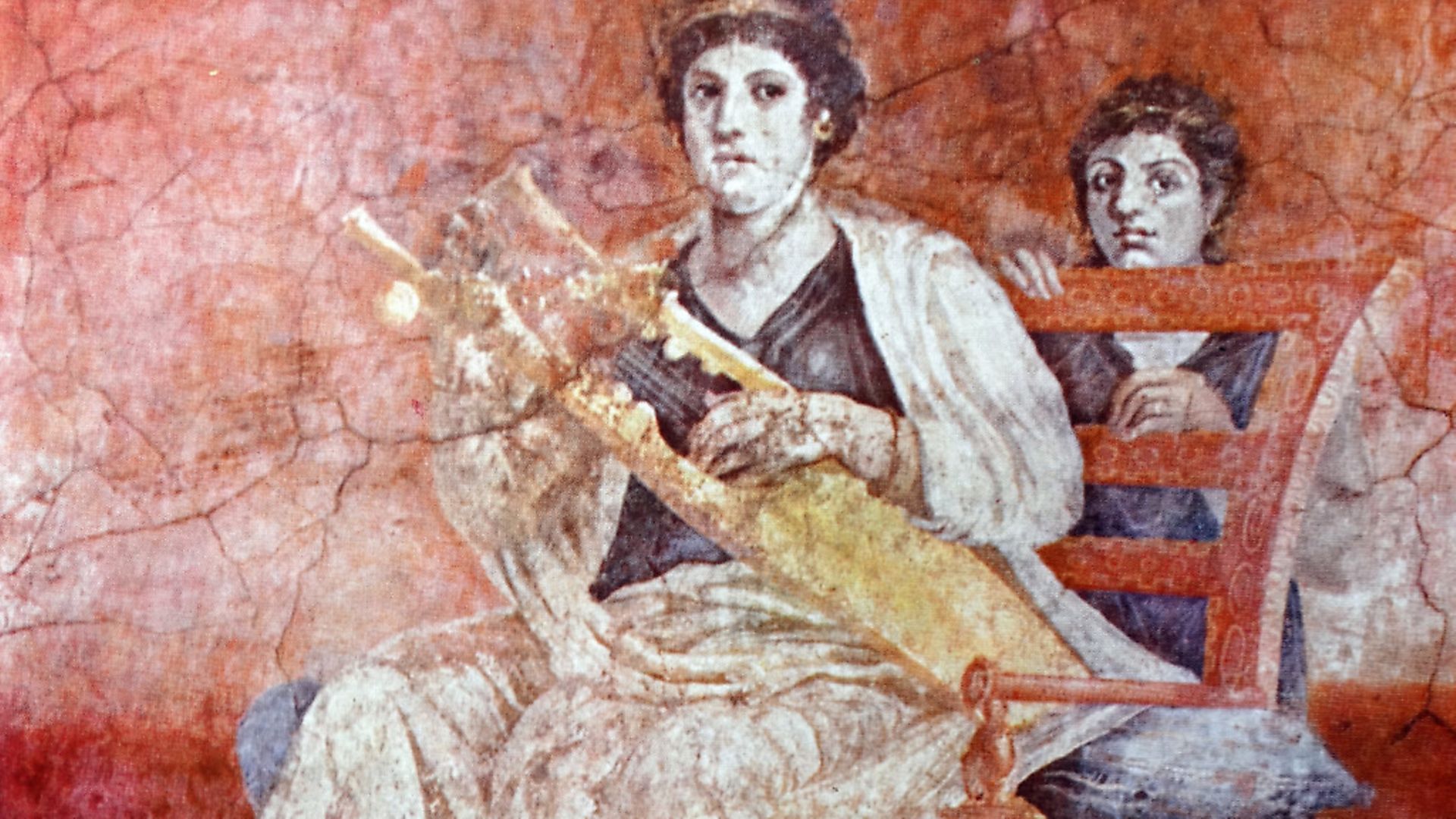
Much remains unclear about the nature of the music produced by the Romans. But, as SOPHIA DEBOICK reports, by piecing together the clues, their creativity can still be heard.
After the ravages of the Great Fire of Rome, the reign of Nero, multiple civil wars and the disasters at Pompeii and Herculaneum the previous year, the Roman world was leaving the strife of the past behind and facing the penultimate decade of the 1st century with a sense of confidence. The Emperor Vespasian had brought peace and stability in his 10-year reign and when his son, Titus, had succeeded him in June 79 AD the Flavian dynasty continued.
In 80 AD itself, Titus moved quickly to secure popularity, finishing the building of the Colosseum begun by his father and holding an inaugural 100 days of games. The Spanish-born poet, Martial, published his Liber Spectaculorum, a psychedelically vivid account of those games that year (‘Shown along thy Arena’s floor, O Caesar, a rhinoceros afforded thee an unpromised fray. Oh, into what dreadful rage fired he with lowered head!’).
Pliny the Younger was 19 and soon to embark on his law career while his friend, the historian Tacitus, was in his mid-20s and recently married to the daughter of Agricola, the great Gallo-Roman general. Agricola was at that time busy quelling rebellion in Britain and would exert a dominance over the whole of the country as governor that far exceeded anything previously achieved by the invaders. Sussex’s Fishbourne Palace, probably the home of a Romanised native noble, was newly-completed around this time, indicating how well-ensconced the Romans were in the south. Meanwhile, the 81-mile Eifel Aqueduct was built, taking water into Cologne and proving the Romans’ engineering genius.
Despite the huge reach of Rome, both geographically and intellectually, Nero and Vespasian spent considerable time out of ruling much of the known world to tinker about with musical instruments, and music had an almost totemic importance to the life of Rome.
It was fundamental to many of the public social functions of Roman society, having a central role in dramatic performances, religious rites, and the famous Roman spectacles and games, variously carrying connotations of recreation, worship, mourning, authority and celebration. There were formal collegia and guilds of musicians, indicating it was recognised as a skilled profession. But musicianship was also an important facet of the cultured citizen’s education and essential in the all-important domestic sphere, as music-playing featured at private feasts and was often depicted in frescos in more luxurious villas. Just such a home in Boscoreale, near Pompeii, contains a fresco from just before this period showing a well-dressed woman with a gold hairband playing the lyre-like cithara as her maid looks on – music embodied ideals of refinement and civilization for the Romans.
The essential instruments of the Roman musical world were few but enduring. The woodwind instrument the tibia, a reeded, double pipe instrument, derived from the Greek aulos. It was precisely what one would expect a mischievous, typically Greek satyr to be depicted playing, but it was in fact central to the sounds of Ancient Rome, and more than 60 tibia, including several in expensive ivory, silver and bronze, have been excavated from the ruins of Pompeii.
The Roman tuba, a more than metre-long bronze trumpet, and the thin curved metal cornu looked as imposing as they sounded and were used for all manner of events, including purification rituals, funerals and processions. Packing a punch, they were also adopted by the military to issue orders and sound signals on the battlefield, and a third of a century on from 80 AD, Trajan’s Column showed cornicines and tubicines – musicians specialising in each instrument – playing them during the battles of the Dacian Wars.
These wind instruments were fairly humdrum compared to the lyre and its successor, the cithara. Played by the god of music, Apollo, himself, the lyre had evolved from the instrument made of tortoiseshell and horn known to the Greeks into the more sophisticated wooden cithara, as represented in colossal form in the Vatican Museum’s second century sculpture Apollo Citharoedus.
Affording considerable room for virtuoso inventiveness, the cithara was considered the apotheosis of Roman musical accomplishment. Of considerable technical sophistication, but rather less graceful, was the hydraulic pipe organ, a bulky and rather Heath Robinson affair, involving bellows and a water tank to produce compressed air. As a powered instrument it had a shot at filling arenas and circuses with its sound, and the Libyan Zliten mosaic, possibly dating from around this time, shows a hydraulis being played alongside a tuba and two cornua as an accompaniment to gladiatorial combat – the musicians sit perilously close to the action as a referee constrains a gladiator who has another by the throat, waiting for the verdict of the crowd on whether the defeated man should live or die, while a stretcher waits ominously in the background.
Another image of gladiators from the first century, this time scratched onto a tomb in Pompeii, also shows the figures flanked by tubicines and cornicines. An assortment of percussion instruments completed the core Roman arsenal of instruments, the many examples excavated from Pompeii, including an extremely well-preserved and apparently fully operational pair of cymbals and a discus (a type of gong), making these very tangible indeed.
Yet much remains unclear about the exact nature of Roman music. Instruments involving wood and animal derivatives inevitably decayed and there’s a lack of surviving evidence on the musical notation used. But the seductive pull of Roman culture has persuaded many groups across Europe to try to reconstruct the complete Roman music experience, often drawing on the best scholarship to do so. The Italian group Ludi Scaenici perform in the Etruscan-derived manner of the ludiones (players), who Livy had described as ‘dancing to the sound of tibias without singing themselves and without miming the meaning of the song’. Here, music and improvised dance met in a type of performance associated with the public games in Rome which heavily influenced the development of Roman theatre. The suggestive poses typical of the period found in surviving Roman art inform their dance moves.
Meanwhile, the French Ensemble Kérylos work under the direction of Annie Bélis, who brings to bear expertise as an archaeologist to reconstruct instruments in collaboration with expert luthiers, and as a papyrologist to decipher scores. Bélis’ research resulted in the group reviving the early second century Paean to Apollo by Mesomedes of Crete, preserved in a piece of papyrus in the Egyptian Museum, Berlin. Musica Romana, based in Schwerin, Germany, bring together archaeologists, musicians and dancers in ‘experimental music archaeology’ performances, even using a reconstructed hydraulis on their album Pugnate! (‘Fight!’) to create an approximation of the sounds of the gladiatorial arena.
But perhaps the most successful reconstruction group is Synaulia, the project founded by Milanese composer, multi-instrumentalist and ethnomusicologist Walter Maioli in the mid-1990s, who use reconstructions of a huge range of ancient instruments to play Maioli’s speculative compositions of Roman-style songs. Synaulia really hit the big-time when two of their songs, Pavor and Etruria, were used on the soundtrack to Ridley Scott’s updating of the sword and sandals genre, Gladiator (2000). Scott clearly had some interest in authenticity, even if the lush score by Hans Zimmer with beautiful wordless singing by Dead Can Dance’s Lisa Gerrard erred towards the epic and the emotional.
Zimmer’s soundtrack was surprisingly controversial, the composer being sued by the Holst Foundation over the similarities between Zimmer’s The Battle and Holst’s Mars: The Bringer of War (John Williams had, of course, had similar ideas for Star Wars), but a Nick Cave-scored sequel may have been more sensational still. Cave wrote a script for a sequel to the film which, in a suitably gothic vein, saw its deceased protagonist journey through the afterlife. It was, predictably, shelved, although Cave’s dark take on Ancient Rome would have been an intriguing contribution to contemporary culture’s ongoing engagement with, and remaking of, the image of the Roman world.
The Emperor Titus ruled for but two years before his death, with his younger brother Domitian becoming emperor in 81 AD. Suetonius’ unsympathetic Life of Domitian nevertheless recorded that this was an emperor keen to encourage the arts, holding ‘competitions for choral singing to the lyre and for lyre-playing alone, besides the usual solo singing to lyre accompaniment’. Unlike Nero, these competitions were not held simply so he himself could be crowned the winner, although both issued coinage with lyres and tubicines depicted on them. The importance of music in Rome ran as a thread throughout its 1,300-year history – 80 AD was but one moment in an epic story of artistic endeavour.











